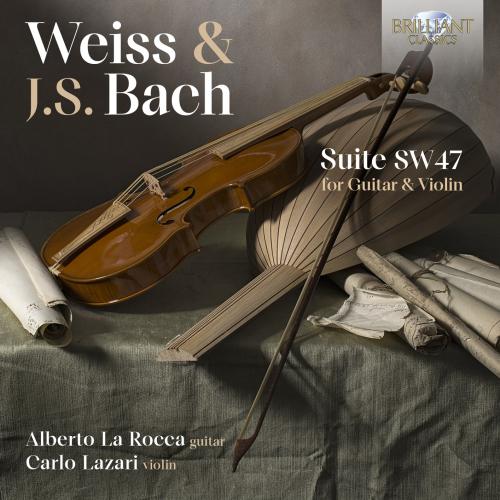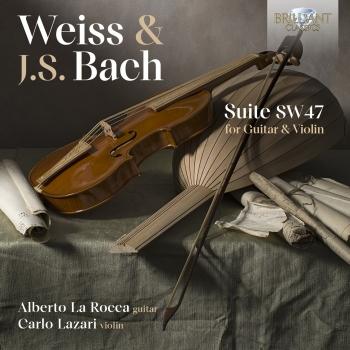
Weiss & J.S. Bach: Suite SW47 for Guitar and Violin Alberto La Rocca & Carlo Lazari
Album info
Album-Release:
2024
HRA-Release:
26.06.2024
Label: Brilliant Classics
Genre: Classical
Subgenre: Instrumental
Artist: Alberto La Rocca & Carlo Lazari
Composer: Sylvius Leopold Weiss (1687-1750), Johann Sebastian Bach (1685–1750)
Album including Album cover Booklet (PDF)
- Silvius Leopold Weiss (1687 - 1750): Suite in A Major, SW47:
- 1 Weiss: Suite in A Major, SW47: I. Entrée (Arr. By Alberto La Rocca) 03:42
- 2 Weiss: Suite in A Major, SW47: II. Currante (Arr. By Alberto La Rocca) 04:43
- 3 Weiss: Suite in A Major, SW47: III. Rondeau (Arr. By Alberto La Rocca) 03:15
- 4 Weiss: Suite in A Major, SW47: IV. Sarabande (Arr. By Alberto La Rocca) 05:29
- 5 Weiss: Suite in A Major, SW47: V. Allegro (Arr. By Alberto La Rocca) 05:09
- 6 Weiss: Suite in A Major, SW47: VI. Men(Uet) [Arr. By Alberto La Rocca] 02:44
- Johann Sebastian Bach (1685 - 1750), Silvius Leopold Weiss: Suite in A Major, BWV1025 after Weiss's Suite, SW47:
- 7 Bach, Weiss: Suite in A Major, BWV1025 after Weiss's Suite, SW47: I. Fantasia (By J.S. Bach) [Arr. By Alberto La Rocca] 02:52
- 8 Bach, Weiss: Suite in A Major, BWV1025 after Weiss's Suite, SW47: II. Courante (Arr. By Alberto La Rocca) 04:43
- 9 Bach, Weiss: Suite in A Major, BWV1025 after Weiss's Suite, SW47: III. Entrée (Arr. By Alberto La Rocca) 03:29
- 10 Bach, Weiss: Suite in A Major, BWV1025 after Weiss's Suite, SW47: IV. Rondeau (Arr. By Alberto La Rocca) 03:30
- 11 Bach, Weiss: Suite in A Major, BWV1025 after Weiss's Suite, SW47: V. Sarabande (Arr. By Alberto La Rocca) 05:06
- 12 Bach, Weiss: Suite in A Major, BWV1025 after Weiss's Suite, SW47: VI. Menuet (Arr. By Alberto La Rocca) 02:52
- 13 Bach, Weiss: Suite in A Major, BWV1025 after Weiss's Suite, SW47: VII. Allegro (Arr. By Alberto La Rocca) 05:30
Info for Weiss & J.S. Bach: Suite SW47 for Guitar and Violin
This recording features a work with a strange coincidence in its compositional process and an astonishing dual authorship. Remarkably, Silvius Leopold Weiss’s Lute Suite SW47 (which he named Suonata) also comes with a violin part that can be played over the top of it, composed by none other than Johann Sebastian Bach. A recent comparison of sources revealed that the harpsichord part in Bach’s Suite for Violin & Harpsichord BWV1025, long considered to be of doubtful attribution, perfectly matches Weiss’s suite. The violin part, meanwhile, was indeed composed entirely by Bach and is an additional melody independent of Weiss’s musical material. It feels almost like a ‘free improvisation’ above the suite and recalls a similar process carried out by Charles Gounod in 1859: his Ave Maria fits over the first Prelude from Bach’s Well-Tempered Clavier BWV846. The sole exception is the Fantasia movement in Bach’s piece, which is not derived from Weiss’s suite, meaning both the violin and harpsichord parts in it are unique to Bach.
This recording presents Weiss’s suite on its own and with the addition of Bach’s violin part, both versions arranged by guitarist Alberto La Rocca for his instrument in place of the lute or harpsichord. (The all-Bach Fantasia is not included in the version without violin.) Weiss’s Suite (Suonata) is a high-quality work composed for a 13-course Baroque lute. It is rarely, if ever, performed by either lute or guitar players, yet it contains all the best features of the great German lutenist’s oeuvre: a refined and elegant compositional style and a varied range of expression. Bach’s ‘added melody’, composed with his usual superhuman ability, shines a new light on the original suite, as if dressing it up in extraordinarily elegant attire. The violin part comments on the original lute texture without suffocating it, almost like a free improvisation above it. It plays with the various elements of Weiss’s music, extrapolating ideas for themes, imitating them or simply wandering freely. Bach’s part is also highly imaginative and varied in its expression, frequently adding complex rhythmic dovetailing and significant virtuosity while always staying true to the emotions of Weiss’s movements. Bach and Weiss were friends and met on several occasions. Johann Friedrich Reichardt even describes them challenging each other to an improvisation competition: ‘Anyone who understands the challenge of playing harmonic modulations and decent counterpoint on the lute will be surprised and amazed to hear an eyewitness say that Weiss, the great lutenist, competed with J.S. Bach, the great harpsichordist and organist, in playing fantasies and fugues.’ While the origins of his ‘transcription with accompaniment’ of Weiss’s Suite SW47 are still a mystery, the fact remains that we can now enjoy a unique and unusual masterpiece, which these two brilliant composers had a hand in writing.
Alberto La Rocca, guitar
Carlo Lazari, violin
Alberto La Rocca
was born in Sora, Italy on January 30, 1924. He sacrificed his life to save the lives of ten of Fiesole's citizens on August 12, 1944. La Rocca lived a short, but principled, life. As a Carabiniere, his duty was to his country and to its residents. It was a duty from which he never flagged, overcoming the brutality of the Second World War to provide aid to the Italian populace.
The power of La Rocca's sacrifice cannot be overstated. In a difficult epoch, the Carabiniere was faced with a choice few would accept. The supreme altruism of his act serves as a model for a new generation of adults. The youth of Vaughan are honoured by the opportunity to pay tribute to La Rocca by accepting the bursary which bears his name.
As Vaughan and Sora are cities linked by a twinning agreement forged in 1992, it is imperative that they share a common legacy. The celebration of Sora's heroes is the celebration of the heroic people within our own city. The recognition of La Rocca's actions allows Vaughan's youth to replicate his pattern of altruism, and from this, the elevation of selfless acts comes to the fore in their civic life. The youth who receive this award carry with them the hopes of the two cities for a better world and embody the courage of certainty; allowing them to give of themselves without question.
Alberto La Rocca was honoured by the City of Vaughan in 2001 with the dedication of a park and statue to his memory. In 2002, recognizing the ability of La Rocca's story to inspire Vaughan's youth, Mario Ferri and a committed group of citizens founded the La Rocca Bursary. This bursary is awarded annually to youth who lead their lives by the principles of altruism, service and life.
Carlo Lazari
Born in Venice in 1962, he began studying the violin at a very young age with Emilio Cristinelli and, after graduating from high school, he obtained his diploma in violin in 1984 with top marks at the Conservatory of Venice under the guidance of Renato Zanettovich. He then continued his study of the violin repertoire at the Stauffer Academy in Cremona with Salvatore Accardo and at the Scuola di Musica di Fiesole with Stefan Gheorghiu.
He also took part in master classes held by Franco Gulli and Henryk Szering at the Accademia Chigiana in Siena and Nathan Milstein at the Muraltengut in Zurich.
He was awarded first prize at the 9th 'A.Curci' International Violin Competition.
He has been playing regularly for more than 25 years with the Ex Novo Ensemble of Venice, with whom he has made numerous recordings with monographic programmes by E. Wolf-Ferrari, F. Busoni, G. Donizetti, G. Rossini, G. Sgambati, G. F. Malipiero, G. Martucci, O. Respighi, A. Schoenberg, B. Maderna, Luciano Berio as well as works by A. Casella, I. Pizzetti and N. Rota.
He is a member of the ensemble "I Solisti Filarmonici Italiani" with whom he records for Denon and tours all over the world.
On the philological side, as a baroque violinist he is engaged with the ensemble "L'Arte dell'Arco" in the complete recording of Giuseppe Tartini's violin concertos.
Booklet for Weiss & J.S. Bach: Suite SW47 for Guitar and Violin










